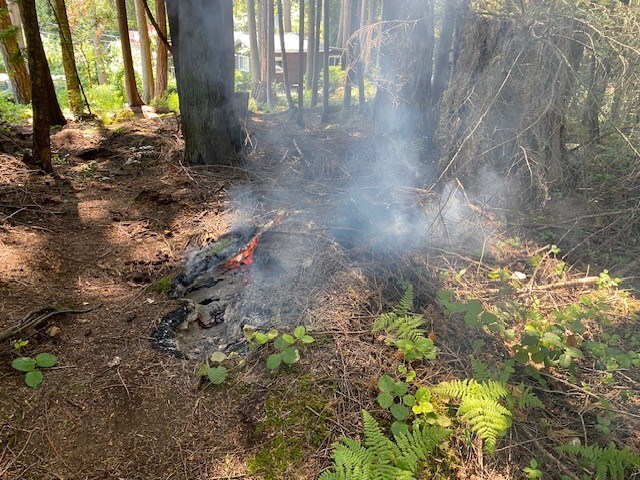During June, two incidents believed to be smoking related had the potential to cause wildfires along Roberts Creek area trails.
On June 23, fire chief Pat Higgins was the first responder from the Roberts Creek Volunteer Fire Department on-scene at a small burn along a trail behind Flume Creek. He told Coast Reporter it was successfully extinguished before it could develop into something larger and more dangerous. Signs of a fire were reported by people on the trail and by the time Higgins arrived, it had spread in surrounding dead fall.
“A couple of logs actually burned through, so it got pretty hot on the ground. It was right next to the trail, so likely smoking material caused, as that’s not a place where anyone would have a campfire,” he said.
That incident followed one reported along the same walking route three weeks earlier in a grassy area close to the rear of the Ikon mobile home park. Higgins also attended that scene. He said “residents had put water on a small smouldering burn and we could see the discarded cigarette butt sitting in it." That burn was also addressed quickly and caused no serious damage.
Those occurrences have elevated the risks caused by smoking while on trails to a “major concern” for his and other Sunshine Coast fire departments.
“These things were both realities, there’s nothing hypothetical here.”
Dangers go beyond butts
Improper disposal of cigarette butts is something Higgins said most people recognize as a fire risk. But he views having lit smoking material of any kind while in the outdoors during the dry ground conditions being experienced locally being equally as dangerous, and “just not worth the risk”. This applies not only to trails in forested areas, he said but to areas with dry grass or shrubs such as parks and residential yards.
“A blaze can start from a falling ash," he noted. In such cases, he said the person responsible may not be aware it has happened and even if they are, the ignition point may not be immediately visible.
Fires often start in the top “duff layer” of natural soils which can contain dry organics such as bark, parts of leaves, pinecones and wood fragments. BC Wildfire’s website explains that such fires, in those loosely compacted materials burn rapidly, given that the fuel is “freely exposed to air”, which can allow the fire to accelerate.
Key trail use considerations
Higgins stressed that people using back country and nature trails during wildfire season should not ignite any smoking materials and also need to carry a water bottle and a fully charged cellphone with them. Both are essentials for personal safety and to address any signs of fire that may be encountered. He said the first steps to take if you encounter signs of an active fire is to use the water to douse the suspected burn and then to immediately call *5555 or 911 with details on the incident.
Reporting means that the situation can be assessed and followed up on by fire protection personnel, he noted.
He also pointed out that "dropped, released or mishandled burning substances” are considered violations under the BC WIldfire Act and that by committing such an offence, an individual can be subject to a $575 fine.



